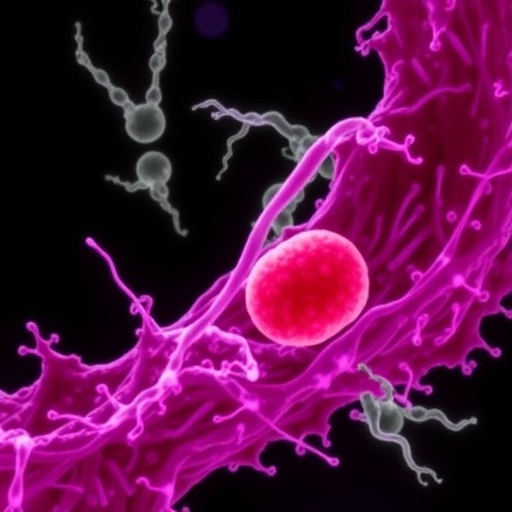In an unexpected twist to our understanding of host-pathogen interactions, recent research reveals that a common fungal commensal, Candida albicans, significantly shapes the virulence of the intestinal pathogen Salmonella Typhimurium. This surprising interplay sheds light on the nuanced metabolic crosstalk occurring within the gut environment, altering both microbial behavior and the host immune response in ways that challenge traditional paradigms.
The study delves deep into the complex microbial ecosystem of the gut, focusing on how C. albicans co-infection influences the inflammatory response typically elicited by Salmonella. Remarkably, instead of exacerbating inflammation as commonly expected with opportunistic fungal pathogens, the presence of C. albicans dampened the host’s immune activation during early Salmonella infection. In mouse models, co-infected animals exhibited a blunted expression of key inflammatory mediators such as interleukin-17 (IL-17) and chemokine (C-X-C motif) ligand 1 (Cxcl1), molecules traditionally associated with neutrophil recruitment and pathogen clearance.
The mechanistic underpinnings of this phenomenon lie in metabolic interactions centered on the amino acid arginine. Through meticulous analysis combining both in vitro and in vivo approaches, the researchers illustrate that C. albicans produces arginine in the presence of Salmonella, thereby locally modulating the nutrient landscape within the gut lumen. Notably, this localized arginine production does not translate into a global increase in gut arginine levels but is sufficient to influence Salmonella gene expression and virulence.
Central to the Salmonella response is the upregulation of genes responsible for arginine uptake and metabolism, particularly the STM4351 gene encoding an arginine-binding protein critical for its transport. The induction of arginine-responsive virulence factors—such as arcA, hilA, and invA—was strictly dependent on the presence of functional arginine transport machinery. Salmonella mutants lacking STM4351 failed to respond to C. albicans-derived arginine signals with enhanced virulence gene expression, underscoring the necessity of microbial nutrient sensing in orchestrating pathogenic behaviors.
Intriguingly, supplementation of the host’s drinking water with exogenous L-arginine mirrored many aspects of the C. albicans co-infection phenotype, including a dampened inflammatory cascade and increased bacterial dissemination to systemic organs like the liver and spleen. This finding reinforces the dual role of arginine—not only as a metabolic substrate but also as a modulator of host immune responses. Prior studies have alluded to the anti-inflammatory properties of arginine in the gut, and this work robustly connects those properties to augmented Salmonella virulence in vivo.
The immunological landscape during Salmonella infection is further complicated by alterations in cytokine profiles and cellular infiltrates. Co-infected mice demonstrated significantly lower serum interferon-gamma (IFNγ) levels and reduced neutrophil infiltration in caecal tissues, which align with the suppressed expression of inflammatory genes. This immunomodulation, orchestrated through arginine-mediated signaling, likely opens a window for enhanced bacterial survival and systemic spread.
To dissect the relative contributions of arginine interactions with the pathogen versus the host, the researchers employed strategies to disrupt arginine uptake selectively. When Salmonella’s arginine transport was compromised via STM4351 deletion, the bacteria lost the capacity to sense and respond to C. albicans-derived arginine, which attenuated their virulence-related gene expression. However, these mutants maintained normal colonization levels, suggesting that arginine’s influence extends to immune evasion and dissemination rather than mere colonization efficiency.
Conversely, inhibiting host arginine uptake with L-lysine—a competitive antagonist for arginine transporters—restored inflammatory gene expression during co-infection and diminished Salmonella burden in systemic organs. This highlights the profound role that nutrient competition and metabolic signaling play in shaping the outcome of polymicrobial infections, opening exciting avenues for therapeutic intervention that target microbial metabolism rather than traditional antimicrobial pathways.
Beyond microbial and host dynamics, the study underscores the ecological reality of the gut microbiota, where seemingly benign commensals like C. albicans can profoundly alter disease trajectories by modulating microbial communication and host physiology. Such findings urge a reconsideration of pathogen virulence as a product of not only microbial genetic determinants but also metabolic interactions within complex microbial communities.
Furthermore, this research serves as a reminder of the metabolic plasticity inherent in both pathogens and commensals, whereby nutrient availability and sensing act as pivotal cues steering infection outcomes. The precise spatial and temporal aspects of arginine production and uptake within the gut microenvironment exemplify how localized metabolic niches can have disproportionate effects on host health and disease.
Importantly, the data also suggest a potential cost to the host for harboring C. albicans during bacterial infection. While the fungus’s presence leads to a muted inflammatory response that might otherwise be protective, this immune dampening facilitates Salmonella systemic spread, thereby exacerbating disease severity. The intricate balance between immune defense and immunopathology is therefore influenced by interkingdom metabolic interactions that have previously been underappreciated.
As the field of infection biology advances, the convergence of microbial metabolism, immune modulation, and pathogen virulence continues to reveal novel facets of disease ecology. This study’s insights into arginine-mediated cross-talk between C. albicans and Salmonella illuminate the multifaceted nature of host–microbe interactions and emphasize the importance of considering microbial consortia in therapeutic design.
Collectively, these findings open the door to innovative approaches targeting metabolic pathways to modulate infection outcomes. By disrupting arginine availability or transport—either at the microbial or host level—it may be possible to recalibrate the immune response and restrain pathogen virulence. Such strategies could be particularly valuable amidst rising antimicrobial resistance, underscoring the translational potential of metabolism-focused interventions.
In sum, the discovery that a commensal yeast can promote Salmonella virulence through arginine-mediated mechanisms highlights the profound impact of metabolic cooperation between microbes and the host. This work challenges existing notions of pathogenesis and immune regulation, illustrating the dynamic interplay that underpins infectious diseases in complex biological systems.
Subject of Research:
Interactions between Candida albicans and Salmonella Typhimurium during gastrointestinal infection; role of arginine metabolism in modulating host immune responses and pathogen virulence.
Article Title:
Commensal yeast promotes Salmonella Typhimurium virulence
Article References:
Jaswal, K., Todd, O.A., Flores Audelo, R.C. et al. Commensal yeast promotes Salmonella Typhimurium virulence. Nature (2025). https://doi.org/10.1038/s41586-025-09415-y
Image Credits: AI Generated




